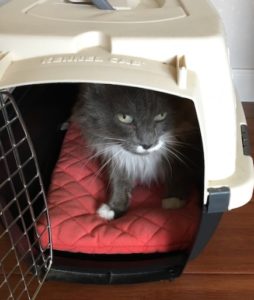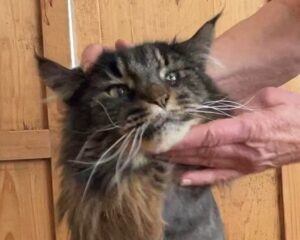
Working at a cat hospital, I have become sensitized to my patients’ distress. Many cats are terrified coming to the veterinary clinic. The experience is not only stressful for the cat but it can be stressful for you, the cat owner. Perhaps you feel embarrassed when your cat misbehaves or maybe you just dread the ordeal of getting your cat into his carrier. These are a few of the reasons why we don’t see as many cats at a veterinary clinic as dogs, although cats outnumber dogs as pets.
The net result of this stress and anxiety is that you may delay medical care for your cat because getting to the vet is so stressful.
What can we do to reduce the fear and anxiety of the vet visit for us and our kitties?
This is the first of a series of posts about making vet visits better for your cat. We will start by looking at how your cat feels about the vet clinic.
making vet visits better for your cat (and you!)
from the feline perspective
You know something’s up – your carrier is out. You hide under the bed but your human pulls you out and proceeds to squeeze you into the dreaded box.
You swing along in the air and then are loaded into a larger box that moves and smells funny.
You finally stop moving and swing through the air some more and arrive at another house where you smell lots of other animals. Oh no, not this place again! You can smell other cats – most of these cats too are afraid. As you move through the fog of smells, you arrive in a small room with a metal table.
A strange human opens your carrier door and tries to coax you to come out – you’re not sure what is out there but now your carrier seems like a good place to stay.
Suddenly, your world tilts and you slide out of the carrier onto the cold, hard table.
You hiss your displeasure. Another strange human proceeds to look into your eyes, put a hard plastic thing in your ears, and presses a cold metal disc against your chest.
Then, the strange human pokes you with a needle and you are finally allowed to escape back into the dreaded carrier – at least, it has taken you back home before.
The veterinary visit can make the most mellow cat anxious.
Does your cat…
- Turn into a frozen lump on the exam table?
- Or does he become a Tasmanian devil, hissing and striking at the veterinary staff?
- Or will he frantically eat the treats offered in an effort to soothe himself?
How can we ask our cats to accept handling and medical exams?
Making vet visits better for your cat (and you!)
 Sedation is one way to relieve anxiety and fear. But sedation works better when your cat is used to being handled. (For more about sedation, see https://www.felinepurrspective.com/medication-before-your-cats-vet-visit/).
Sedation is one way to relieve anxiety and fear. But sedation works better when your cat is used to being handled. (For more about sedation, see https://www.felinepurrspective.com/medication-before-your-cats-vet-visit/).
In this series of posts, we are going train our cats to accept the handling that goes along with the veterinary exam. We will break the vet visit down into parts and work on making your cat comfortable with each part. We will use a technique known as “clicker training” to communicate safety and familiarity to your cat. Your cat voluntarily accepts handling in exchange for something he likes. In this way, your cat becomes an active participant in his health care.
THE VET VISIT IN PIECES
- Getting kitty into the cat carrier
- The car ride
- The waiting room
- The exam room/vet exam
- Other procedures
- Homeward bound
From getting your cat into her carrier to the return trip to home, training can help reduce situational anxiety by making handling and traveling positive, familiar experiences.
However, don’t expect your cat to go through his entire repertoire of behaviors in a distracting environment with strange people such as the veterinary clinic. Unless you train your cat in such an environment, he may behave as if he has never done any of these things before. However, because he is used to being handled, appropriate handling should not elicit defensive behavior.
A frightened cat fighting for his life is very intimidating to handle. However, the past 2 decades has seen the advent of stress-free handling techniques designed to address the frightened cat. If you have concerns about how your cat is handled at the veterinary practice, consider taking your cat to a Cat Friendly practice, where staff is trained in feline handling techniques.
Making vet visits better for your cat is challenging, even if your cat is calm, relaxed and food motivated. We will start next week with carrier training.

